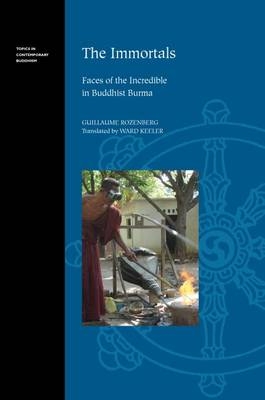
The Immortals
Faces of the Incredible in Buddhist Burma
Seiten
2015
University of Hawai'i Press (Verlag)
978-0-8248-4096-9 (ISBN)
University of Hawai'i Press (Verlag)
978-0-8248-4096-9 (ISBN)
The cult of the four weikza raises a number of classic anthropological issues, particularly for the anthropology of religion. It also provides a window on contemporary Burmese society. This study makes clear both the indigenous take on reality and the work of anthropological understanding as it is being elaborated, along with the ties that connect the latter to the former.
In 1952 a twenty-six-year-old man living in a village in Central Burma was possessed by weikza - humans with extraordinary powers, including immortality. Key figures inBurmese Buddhism, weikza do not die but live on in an invisible realm. From there they re-enter the world through possession to care for people’s temporal and spiritual needs while protecting and propagating Buddhism. A cult quickly formed around the young peasant, the chosen medium for four weikza ranging in age from 150 to 1000 years. In addition, these weikza appeared regularly in the flesh. The Immortals plunges us into the midst of this cult, which continues to attract followers from all over the country who seek to pay homage to the weikza, receive their teaching, and benefi t from their power.
The cult of the four weikza raises a number of classic anthropological issues, particularly for the anthropology of religion: the nature of the supernatural and of belief; the relations among religion, magic, and science; the experience of possession. It also provides a window on contemporary Burmese society. To contemplate both, the author adopts an unconventional approach, which itself reflects representation in anthropology, or, more precisely, how anthropology uses description and the interpretations description occasions to make sense of what it studies. The writing makes clear both the indigenous take on reality and the work of anthropological understanding as it is being elaborated, along with the ties that connect the latter to the former. Mixing narration of the incredible with reflection on the forms religious experience takes, The Immortals offers us a way to accompany the author into the field and to grasp - to take up and make our own - the anthropologist’s interpretations and the realities to which they pertain.
In 1952 a twenty-six-year-old man living in a village in Central Burma was possessed by weikza - humans with extraordinary powers, including immortality. Key figures inBurmese Buddhism, weikza do not die but live on in an invisible realm. From there they re-enter the world through possession to care for people’s temporal and spiritual needs while protecting and propagating Buddhism. A cult quickly formed around the young peasant, the chosen medium for four weikza ranging in age from 150 to 1000 years. In addition, these weikza appeared regularly in the flesh. The Immortals plunges us into the midst of this cult, which continues to attract followers from all over the country who seek to pay homage to the weikza, receive their teaching, and benefi t from their power.
The cult of the four weikza raises a number of classic anthropological issues, particularly for the anthropology of religion: the nature of the supernatural and of belief; the relations among religion, magic, and science; the experience of possession. It also provides a window on contemporary Burmese society. To contemplate both, the author adopts an unconventional approach, which itself reflects representation in anthropology, or, more precisely, how anthropology uses description and the interpretations description occasions to make sense of what it studies. The writing makes clear both the indigenous take on reality and the work of anthropological understanding as it is being elaborated, along with the ties that connect the latter to the former. Mixing narration of the incredible with reflection on the forms religious experience takes, The Immortals offers us a way to accompany the author into the field and to grasp - to take up and make our own - the anthropologist’s interpretations and the realities to which they pertain.
Guillaume Rozenberg is a researcher and member of the French National Center of Scientific Research at the Center of Social Anthropology, Toulouse, France.
| Reihe/Serie | Topics in Contemporary Buddhism |
|---|---|
| Übersetzer | Ward Keeler |
| Zusatzinfo | 10 illustrations |
| Verlagsort | Honolulu, HI |
| Sprache | englisch |
| Maße | 152 x 229 mm |
| Gewicht | 572 g |
| Themenwelt | Geisteswissenschaften ► Religion / Theologie ► Buddhismus |
| Sozialwissenschaften ► Ethnologie | |
| Sozialwissenschaften ► Soziologie | |
| ISBN-10 | 0-8248-4096-8 / 0824840968 |
| ISBN-13 | 978-0-8248-4096-9 / 9780824840969 |
| Zustand | Neuware |
| Haben Sie eine Frage zum Produkt? |
Mehr entdecken
aus dem Bereich
aus dem Bereich
Philosophische Betrachtungen
Buch | Softcover (2024)
Aufbau TB (Verlag)
CHF 20,95
Unterweisungen in Zen-Meditation
Buch | Hardcover (2024)
Arkana (Verlag)
CHF 29,90


